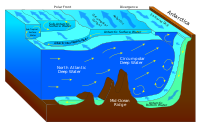
Photo from wikipedia
Warming of surface ocean waters is well known, but how the subsurface waters are changing is less clear. This study shows that subtropical mode water in the North Atlantic and… Click to show full abstract
Warming of surface ocean waters is well known, but how the subsurface waters are changing is less clear. This study shows that subtropical mode water in the North Atlantic and North Pacific is warming at twice the rate of the surface waters. Over the past six decades, the subtropical surface ocean has warmed at rates close to those of global mean surface ocean temperature1 except in western boundary current regions where the surface warming is locally enhanced by a factor of two2. Changes in the subsurface ocean, however, remain unclear because of lack of data. Compiling historical temperature measurements—some available for the first time—here we show that the subtropical mode water has warmed over the past six decades in both the North Pacific and North Atlantic. The rate of the warming is twice as large in the mode waters than at the surface. Subtropical mode waters are important water masses of vertically uniform temperature that are a few hundred metres thick and distributed widely in the main thermocline of the subtropical oceans3. The enhanced warming of subtropical mode waters can be traced back to the surface warming in the formation regions along the western boundary current extensions. Furthermore, we detect increased temperature stratification and decreased dissolved oxygen in the subtropical mode waters. The latter change has clear implications for predicting biogeochemical responses to climate warming.
Journal Title: Nature Climate Change
Year Published: 2017
Link to full text (if available)
Share on Social Media: Sign Up to like & get
recommendations!